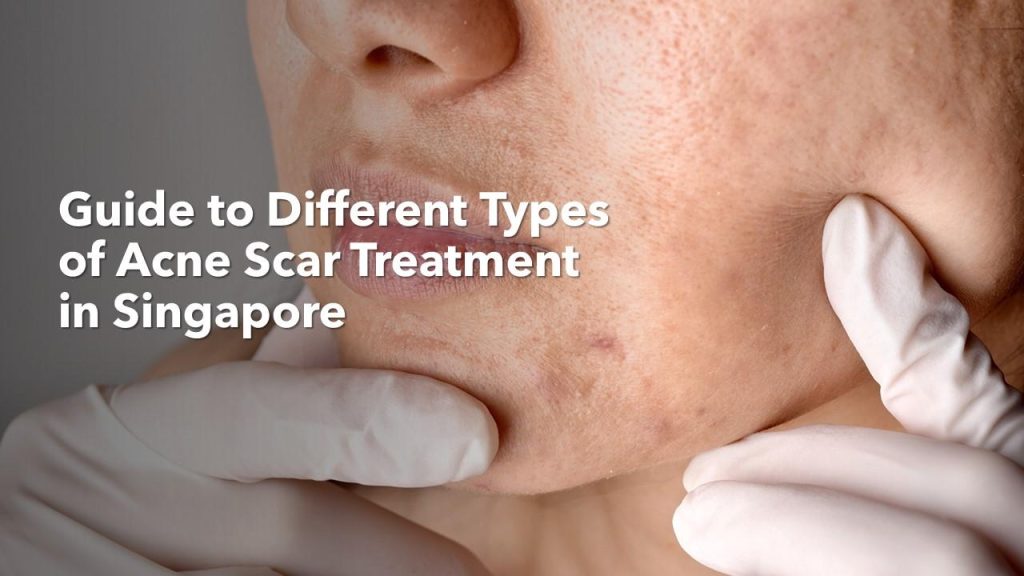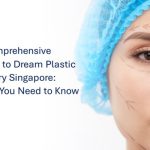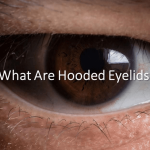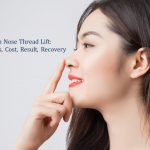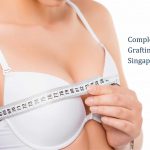Acne scars, a common aftermath of acne, can have lasting impacts on both skin appearance and psychological well-being. This comprehensive guide delves into the various types of acne scars and their treatments available in Singapore, offering insights for those seeking for solutions to this challenging condition.
Overview of Acne and Acne Scars
Acne is a prevalent skin condition, often emerging during adolescence but frequently persisting into adulthood. It impacts a significant portion of the population, primarily targeting the pilo-sebaceous units of the skin. These units are most densely located in areas such as the face, back, and chest.
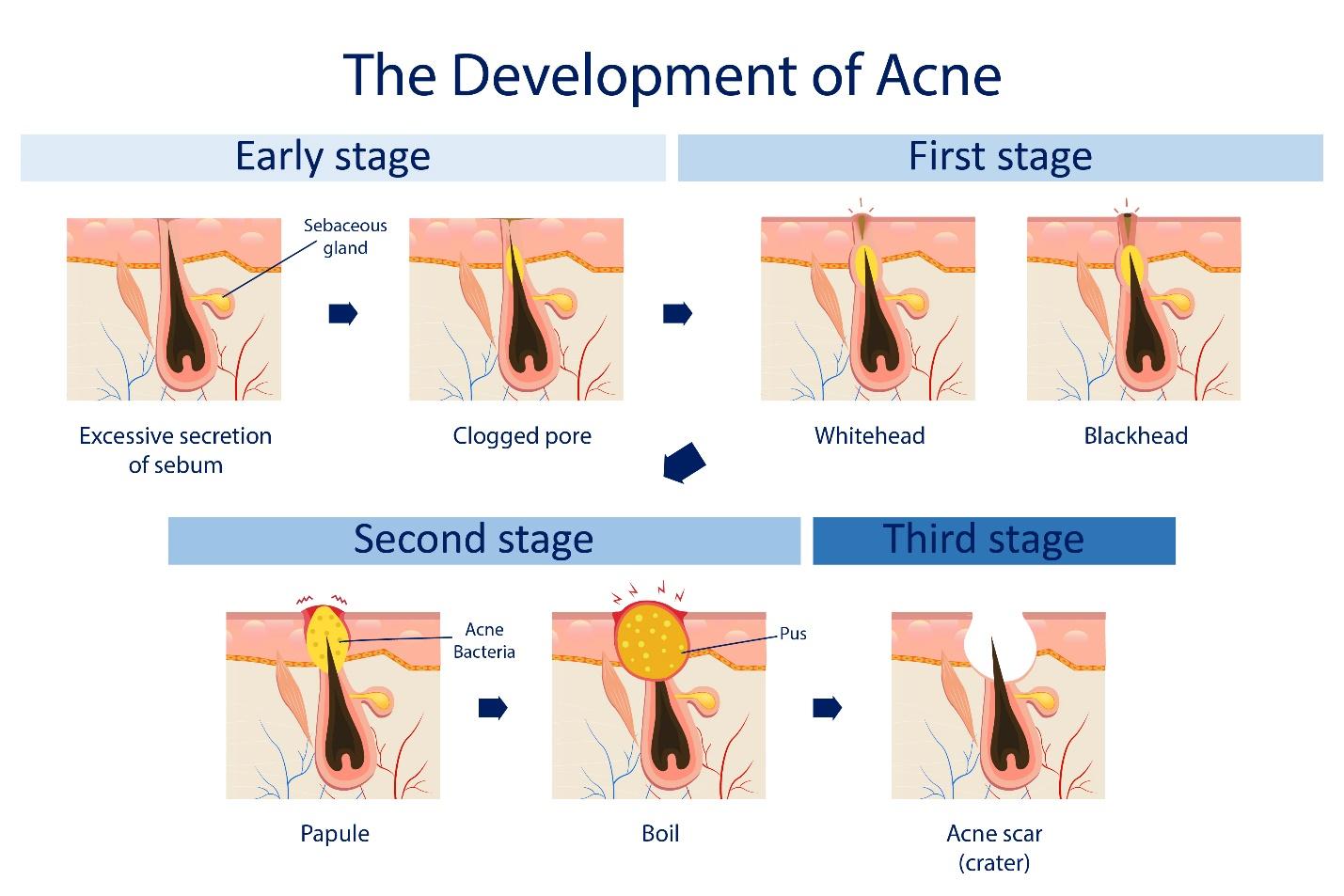
The development of acne involves several stages. It begins with non-inflammatory lesions like whiteheads (closed comedones) and blackheads (open comedones). As the condition progresses, it can evolve into inflammatory lesions, including papules (small red bumps), pustules (pus-filled lesions), and in more severe cases, cysts and nodules. These deeper and more painful formations are particularly prone to causing scarring.
Acne scars are a direct consequence of the skin’s healing process following acne outbreaks. They can manifest in various forms, ranging from shallow depressions to raised tissue. The nature and severity of these scars are influenced by factors such as the depth and duration of the acne, the individual’s skin type, and their unique healing processes. This understanding is crucial to ascertain the cause of scarring and forms the foundation for exploring the various treatment options detailed in this guide.
What Are The Causes of Acne?
The onset of acne is attributed to a combination of biological and environmental factors. One primary cause is hormonal changes, particularly during adolescence, which lead to increased sebum production. Sebum is an oily substance secreted by sebaceous glands, and its overproduction can clog pores, forming a breeding ground for acne.
Abnormal hair follicle keratinisation is another contributing factor. In this process, the cells lining the hair follicle behave unusually, leading to blocked pores. These blockages, combined with excessive sebum, create the ideal conditions for acne formation, starting with the earliest forms of pimples, such as whiteheads and blackheads.
Bacterial inflammation also plays a significant role. The bacteria Propionibacterium acnes (P. acnes), which naturally resides in the skin, can proliferate in clogged hair follicles. This bacterial overgrowth triggers an inflammatory response, leading to red, swollen, and sometimes painful acne lesions.
Furthermore, several external factors can exacerbate acne. These include menstrual cycles, which cause hormonal fluctuations leading to increased oil production. Certain occupations, particularly those in hot, humid environments, can aggravate acne, as can the use of specific hair and skin products. Certain medications (such as corticosteroids, lithium, and certain androgens) and stress are also known to worsen acne conditions.
Understanding these causes is essential in developing effective prevention and treatment strategies for acne. It emphasizes that acne is complex, influenced by both internal and external factors, requiring a comprehensive approach for effective management.
The Far-Reaching Effects of Acne
Acne not only affects skin appearance but can also lead to scarring, ranging from temporary pigmentation changes to permanent pitted or raised scars. The psychological impact is significant, causing reduced self-esteem, social withdrawal, and, in severe cases, depression.
The chronic nature of acne, especially in adulthood, brings ongoing frustration and stress. This creates a cycle where stress worsens acne, emphasizing the complex impact on physical appearance, emotional well-being, and social interactions. A comprehensive approach is essential to address acne, considering its holistic impact on health and well-being.
Classifying Acne Scars: Types and Characteristics
Acne scars are categorised based on their appearance and the way they form on the skin.
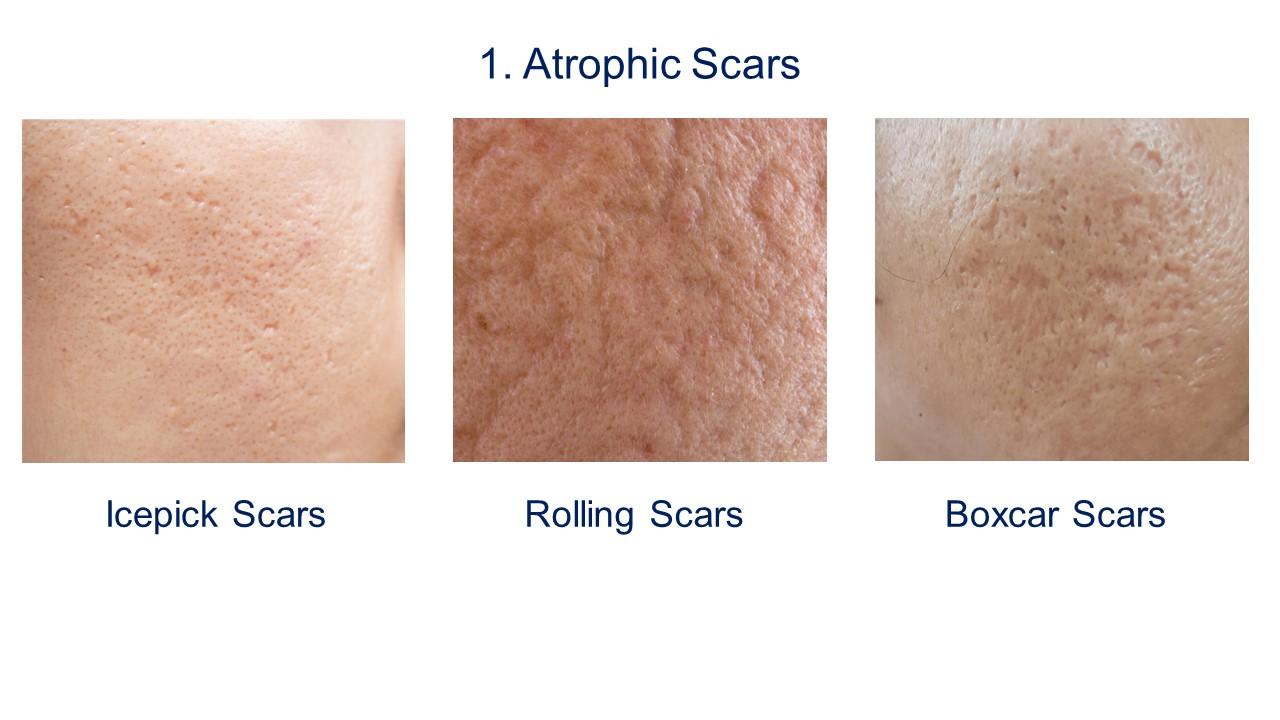
1. Atrophic Scars:
- Icepick Scars: These are deep, narrow, and sharp scars that create small yet noticeable pits in the skin. They are typically difficult to treat due to their depth and narrow opening.
- Boxcar Scars: Wider than icepick scars, boxcar scars have sharp vertical edges, giving the skin a pitted appearance. They vary in depth and are often found on the cheeks and temples.
- Rolling Scars: Caused by fibrous bands of tissue that develop between the skin and the subcutaneous tissue below, these scars give the skin a rolling or undulating appearance. They can become more pronounced with skin ageing and loss of elasticity.
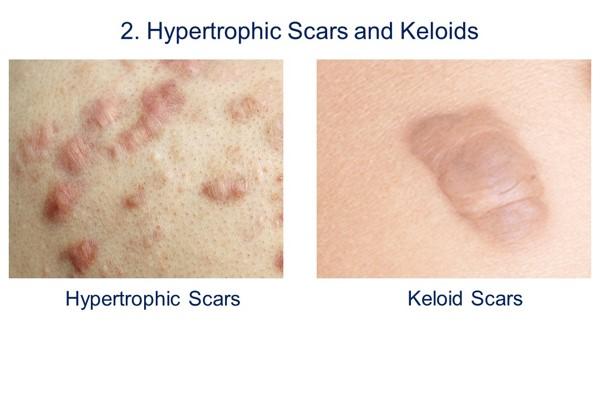
2. Hypertrophic Scars and Keloids:
- Raised above the skin surface, these scars result from an overproduction of collagen during the healing process.
- Keloids: Representing an extreme form of hypertrophic scarring, keloids are characterised by their growth beyond the original boundary of the wound. They are more common in people with darker skin tones and can be itchy or painful.
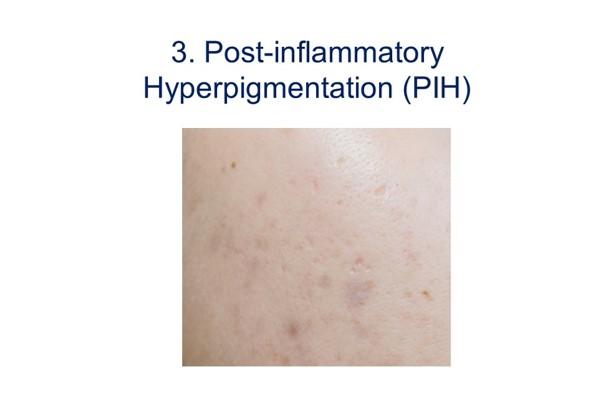
3. Post-inflammatory Hyperpigmentation (PIH):
- These dark spots appear where the acne lesions are located. The overproduction of melanin as a response to the inflammation of acne results in these darkened patches. PIH can fade over time but may persist for months or even years, especially without proper sun protection.
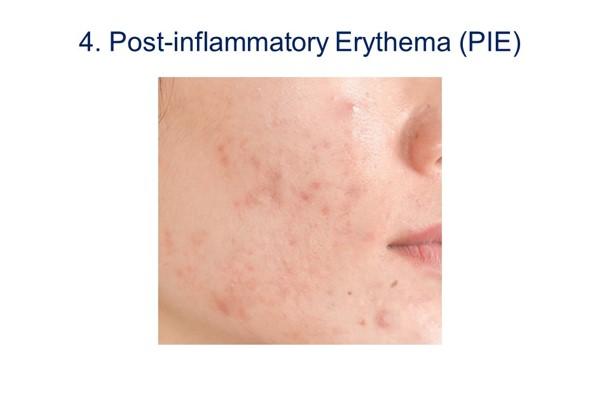
4. Post-inflammatory Erythema (PIE):
- Manifesting as red or purple marks, PIE is the result of damaged or dilated capillaries under the skin’s surface following an inflammatory acne episode. Common in lighter skin tones, these marks usually fade with time but can be persistent, lingering for several months.
Each type of acne scar poses its own set of challenges and requires a tailored approach to treatment. Understanding the nature and characteristics of these scars is vital for doctors and patients alike to embark on the most effective treatment journey.
Comprehensive Approaches to Acne Treatment
A. Topical Therapies
A cornerstone of acne treatment involves topical applications designed to target surface-level issues. Sulfur/resorcinol preparations, with a longstanding history of use, are effective in mild acne cases. Benzoyl peroxide is another common choice, available in various forms such as gels, lotions, or washes. It combats acne bacteria and can aid in clearing blackheads and whiteheads. However, it may cause skin redness and peeling and is less suitable for severe acne cases. Additionally, benzoyl peroxide has a bleaching effect on hair and clothes.
Retinoids, a group of medicated creams derived from vitamin A, are potent against whiteheads and blackheads. Available in different strengths, these include tretinoin, isotretinoin, and adapalene. While effective, they can cause side effects like skin redness and peeling and may increase sensitivity to sunlight. Topical antibiotics, such as erythromycin or clindamycin formulations, target acne-causing bacteria and are available in different bases like water-based gels, moisturising lotions, and alcohol-based solutions.
B. Oral Therapies
For more systemic acne treatment, oral therapies are utilised. Oral antibiotics have been a mainstay since the 1960s, effectively combating bacteria and associated inflammation. Commonly prescribed antibiotics include tetracycline and its derivatives (doxycycline, minocycline) and erythromycin. They require several weeks of administration before their effects become apparent and need to be taken for an adequate duration to prevent relapse.
Oral isotretinoin, derived from vitamin A, is a highly effective option for severe acne or cases resistant to other therapies. However, its use is limited by potential side effects, including dryness of the lips and skin, minor nosebleeds, muscle aches, and changes in blood cholesterol and liver function. Crucially, it poses serious risks during pregnancy, necessitating effective contraception and avoidance of pregnancy during and up to 4 weeks post-treatment.
Hormonal therapy, targeting the hormonal aspect of acne development, presents an alternative to antibiotics or isotretinoin. This includes oral contraceptives with high estrogen content and anti-androgens like cyproterone acetate, which is effective in managing acne in some women. This approach, however, is not suitable for male patients.
The choice of treatment depends on several factors, including the severity and type of acne, the individual’s skin type, and their response to previous treatments. A combination of treatments is often the most effective approach to addressing the multifaceted nature of acne.
Laying Out Options for Acne Scar Treatment
Acne scars, once formed, can be challenging to treat. Treatment modalities range from non-invasive to surgical, each with its own set of techniques and intended outcomes.
1. Non-Invasive Options
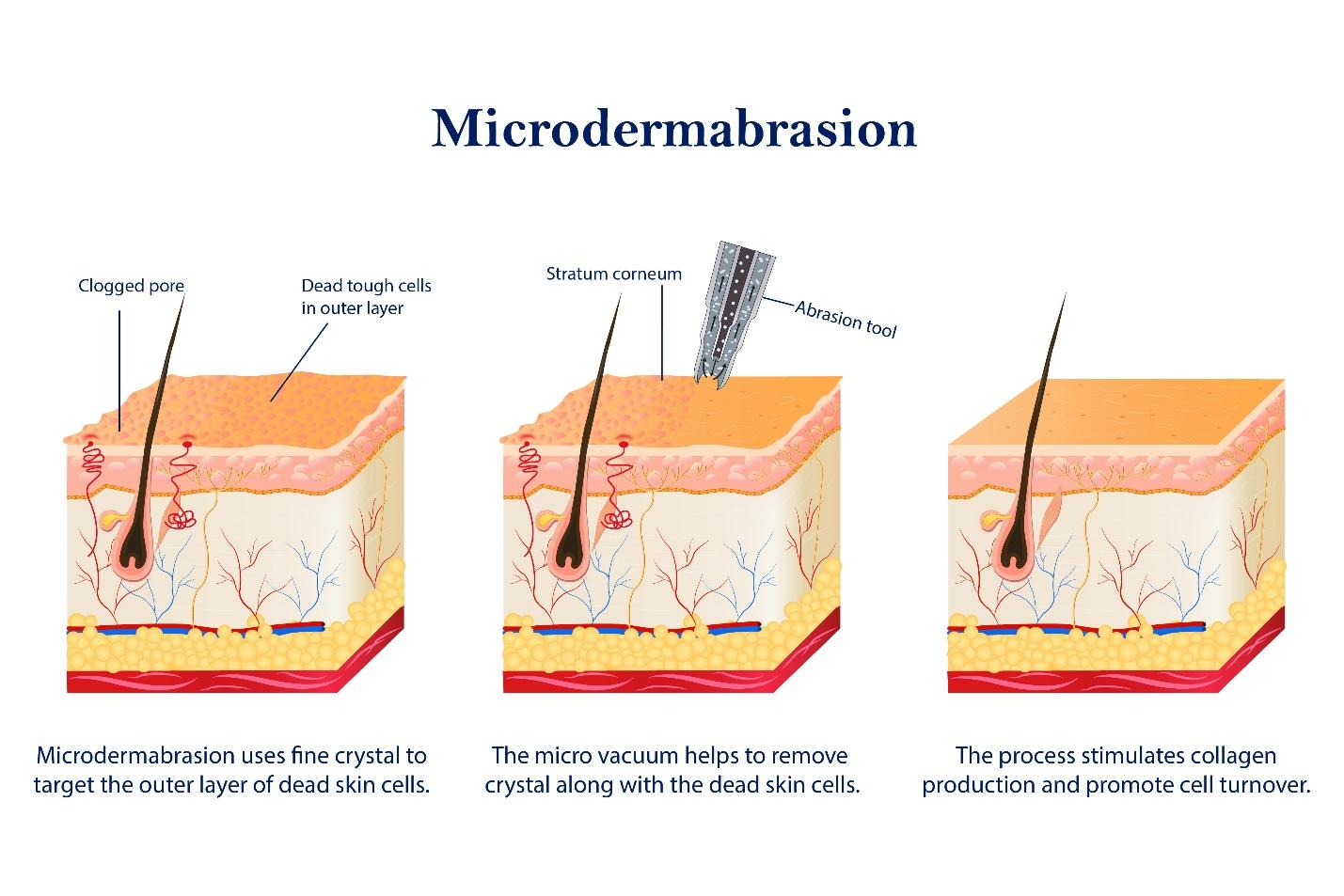
- Microdermabrasion: This is a gentle procedure that exfoliates the skin’s surface, removing the outer layer of dead skin cells. It’s particularly useful for superficial scars and can also help enhance the effectiveness of topical treatment products by allowing better penetration.
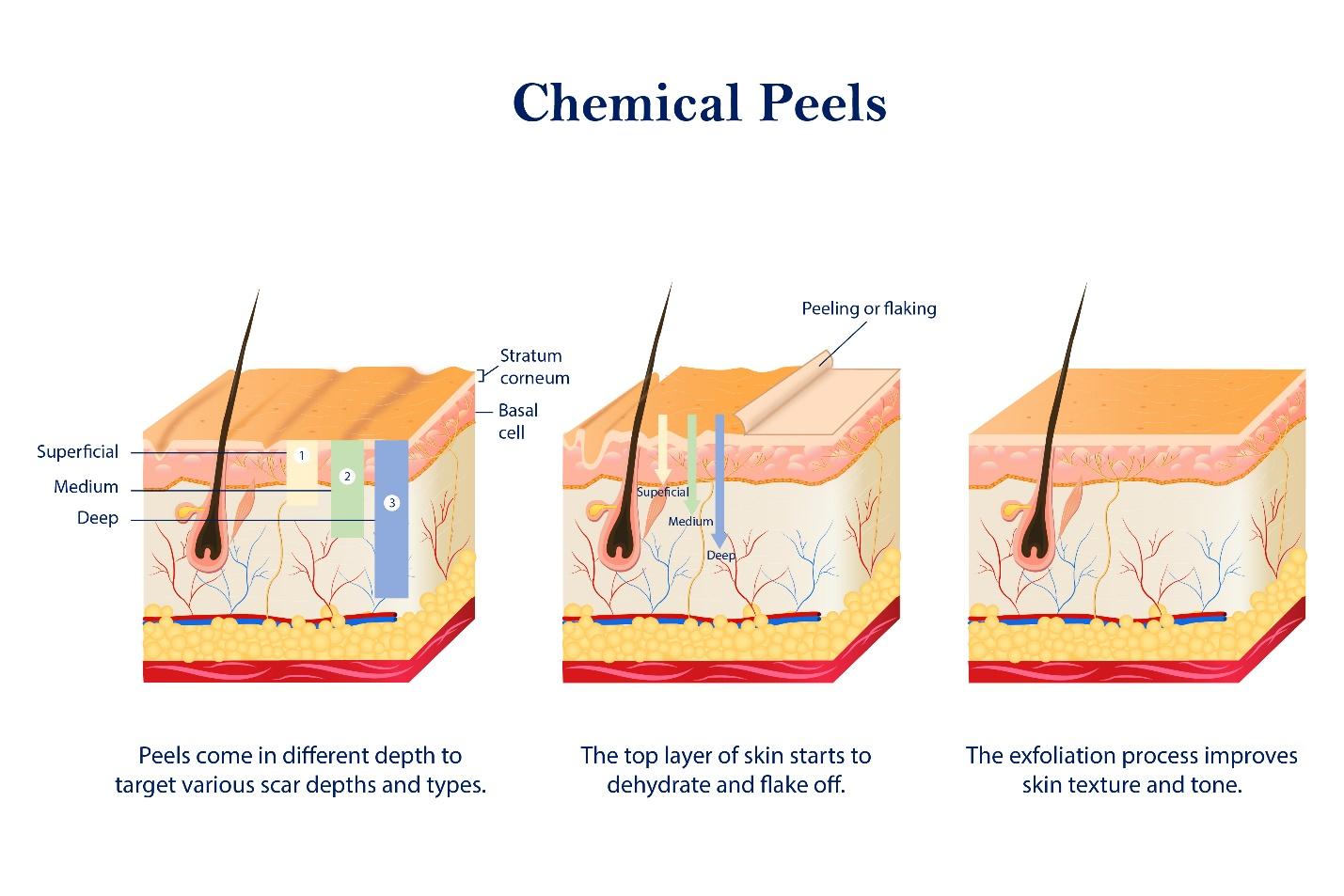
- Chemical Peels: These involve the application of a chemical solution to remove the top layers of skin, prompting the regeneration of new, smoother skin. The depth of the peel can vary, targeting different scar depths and types. Lighter peels are useful for superficial scars, while deeper peels can address more pronounced scarring.
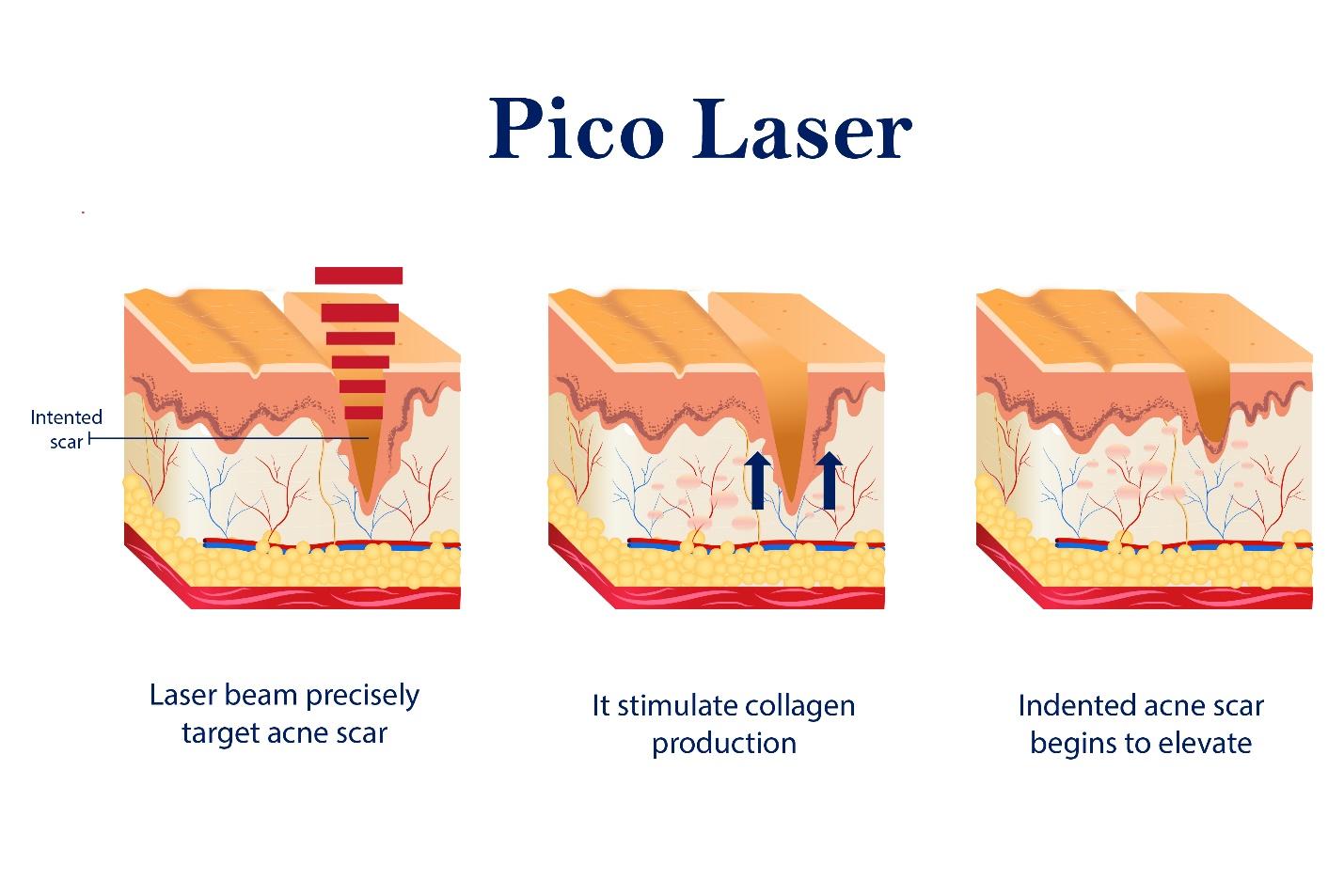
- Pico Laser: Pico laser is a non-invasive laser treatment that uses ultra-short pulses to target pigmentation, fine lines, and acne scars. Its precision allows it to focus on problem areas without damaging surrounding tissue. The laser works by creating a controlled injury to the skin, which stimulates collagen production, leading to improved skin texture and appearance. It is especially effective for treating post-inflammatory hyperpigmentation and shallow scars.
2. Minimally Invasive Procedures
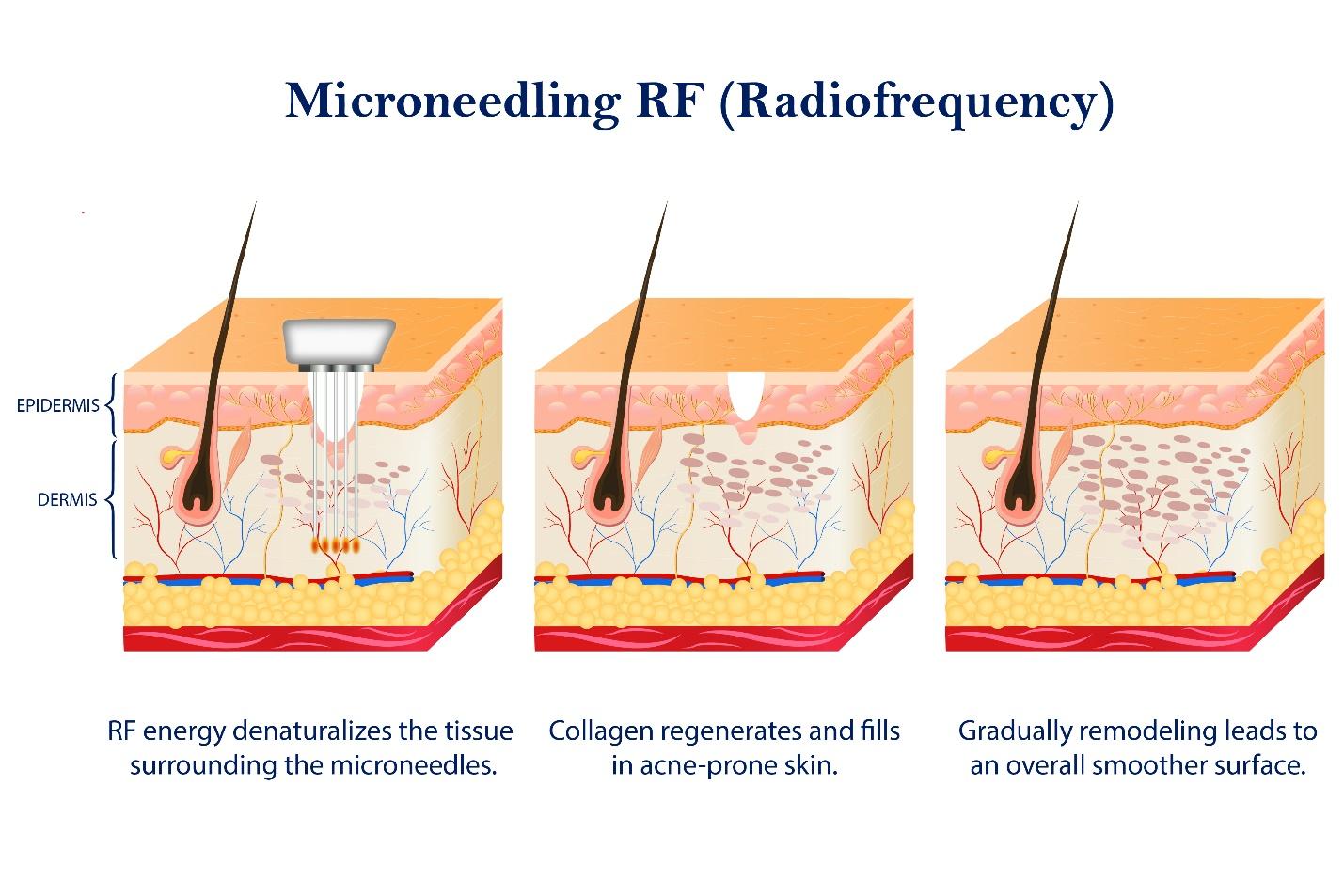
- Microneedling RF (Radiofrequency): This procedure combines microneedling with radiofrequency energy to stimulate collagen and elastin production, improving skin texture and reducing scar appearance. It’s suitable for various types of scars, particularly atrophic scars.
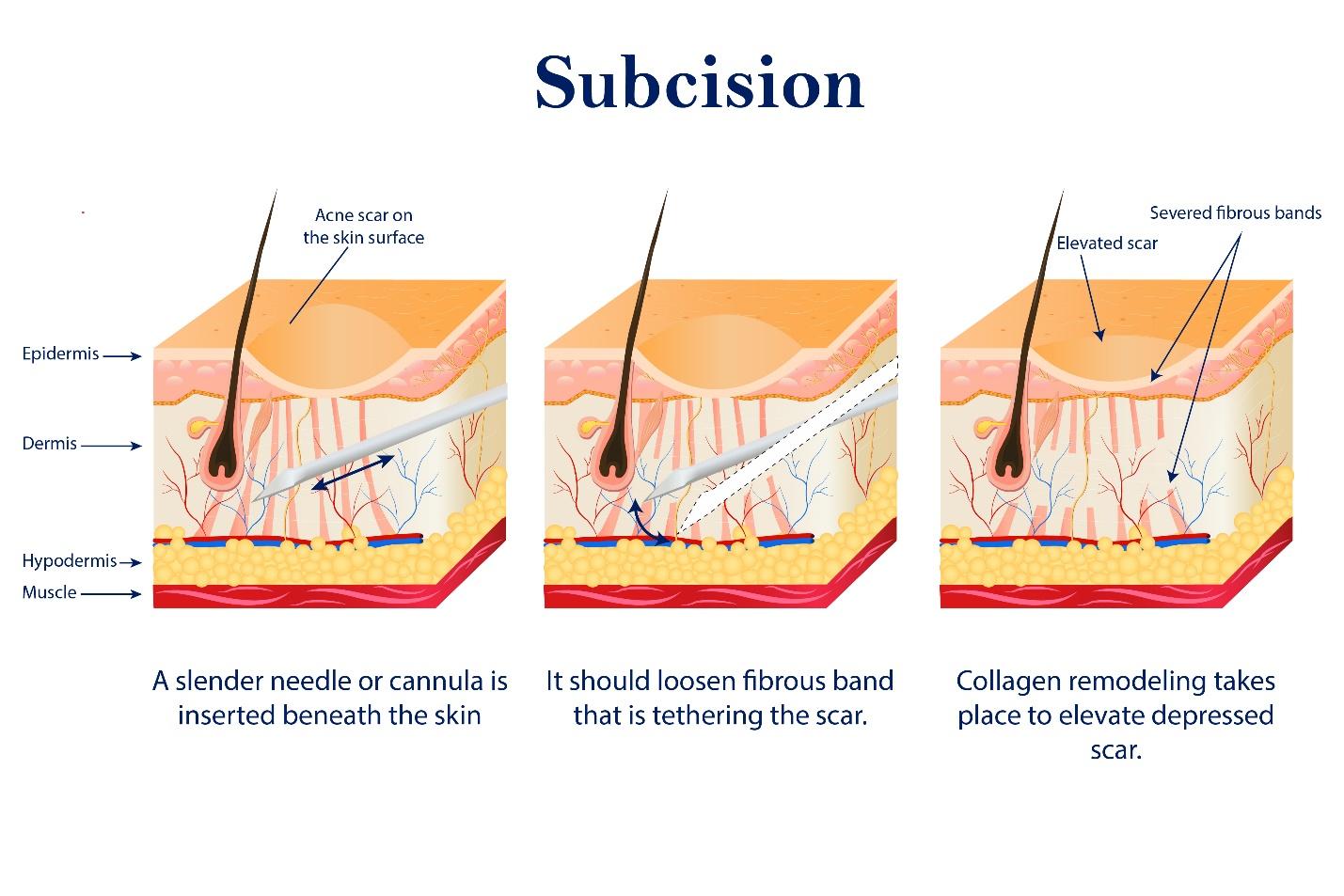
- Subcision: Subcision is a technique used to treat depressed acne scars. A small needle is used to break fibrotic strands that tether the scar to the underlying tissue, releasing the scar and allowing it to rise to the skin’s surface.

- Skinboosters and Injectables: Treatments like polynucleotides (PN) injectables can help in filling out certain types of acne scars, particularly atrophic scars. These substances, injected below the skin’s surface, can stimulate collagen production and improve skin texture.
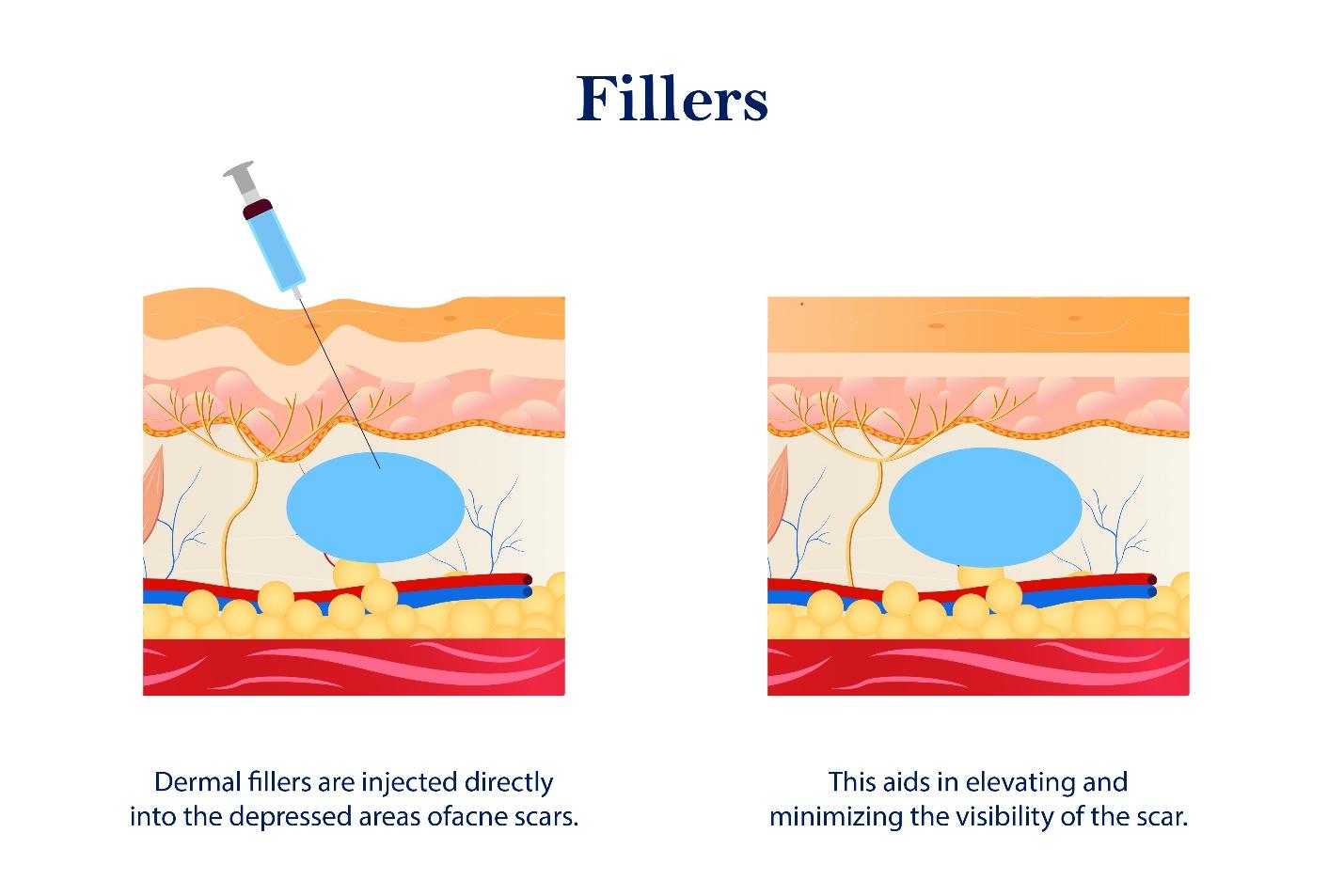
- Fillers: For immediate improvement in the appearance of depressed scars, dermal fillers can be injected to elevate the scar tissue. Results are temporary, requiring regular maintenance.
3. Surgical and Other Option
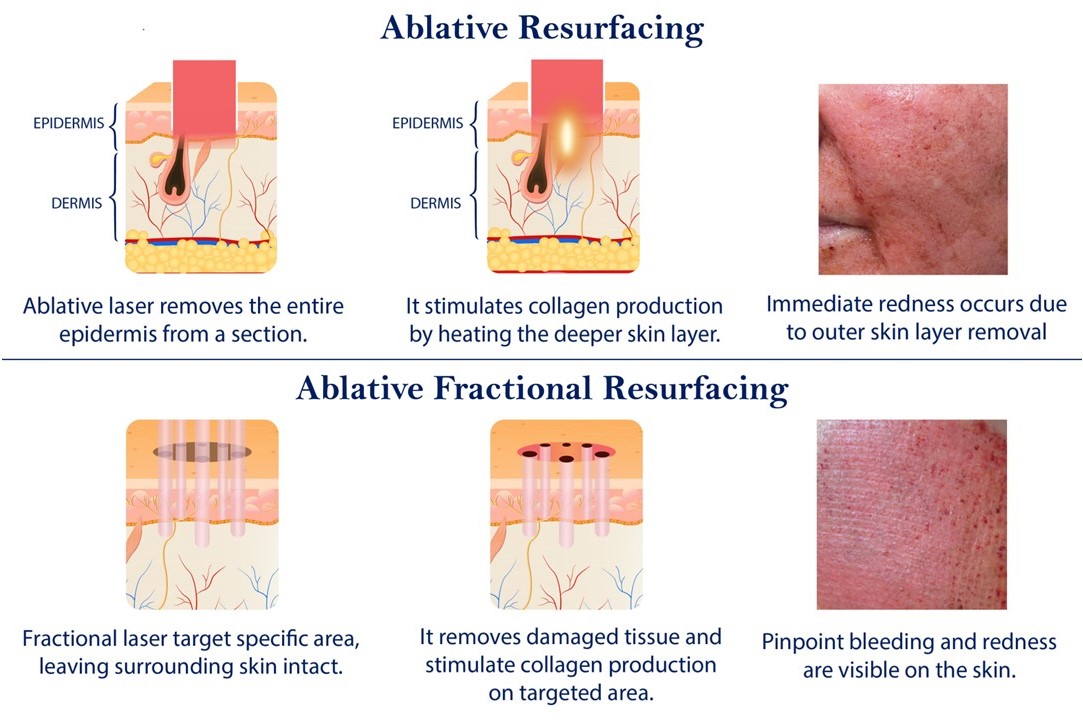
- Laser Resurfacing (Ablative): As a more aggressive approach than its non-ablative counterpart, ablative laser resurfacing removes layers of skin to allow new, smoother skin to form. It’s effective for various scar types but involves more downtime.
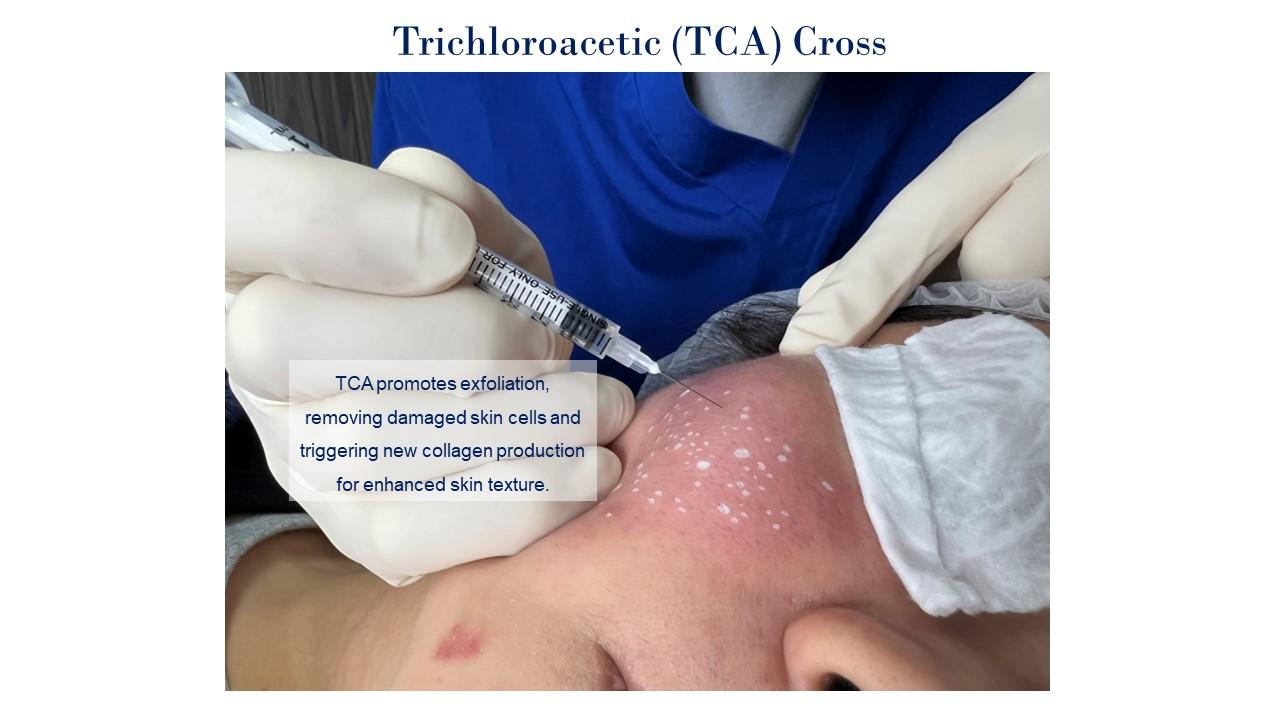
- TCA CROSS: This method involves the application of trichloroacetic acid (TCA) to the base of atrophic scars, particularly icepick and boxcar types. It promotes collagen production at the site of the scar, leading to a smoother skin texture.
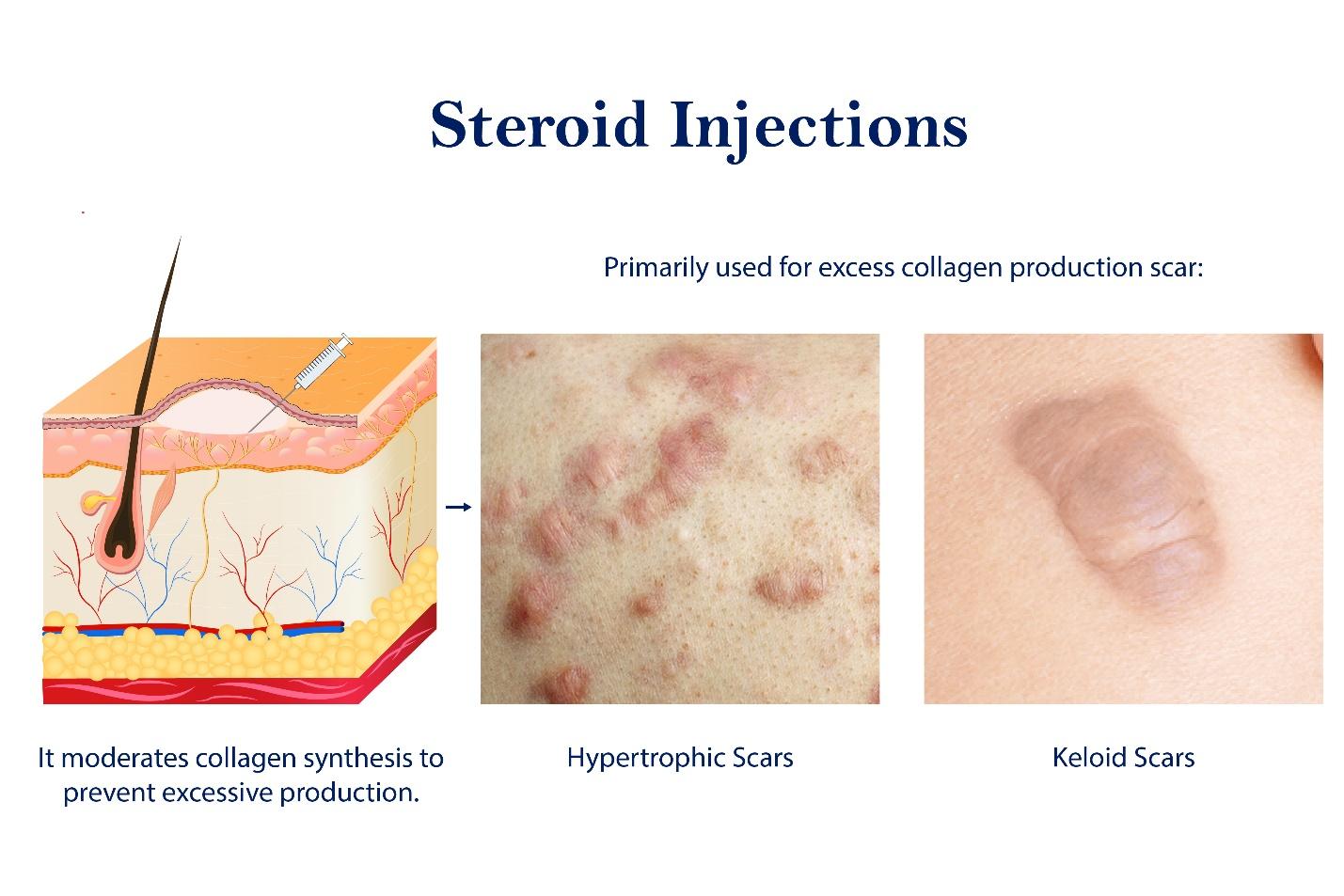
- Steroid Injections: Primarily used for hypertrophic scars and keloids, steroid injections can help reduce scar size and alleviate symptoms like pain and itchiness.
Each of these treatments has its own indications, advantages, and limitations. An individual’s skin type, scar type, and personal health history are all critical factors in determining the most appropriate treatment plan. Professional consultation with an experienced doctor is crucial to navigating these options and selecting the best course of action for improving the appearance of acne scars.
Choosing the Right Acne Scar Treatment: A Concise Guide
- Personalised Treatment Consideration: Selecting an effective treatment for acne scars requires a personalised approach, considering individual skin types, scar severity, and medical history. What works for one person may not suit another, highlighting the importance of customised care.
- Consultation: Consulting an experienced doctor is crucial for tailored treatment plans. They assess scar characteristics and recommend a combination of treatments, adjusting strategies based on the patient’s progress.
- Realistic Expectations and Combined Treatment Approaches: Effective treatment often combines topical treatments, oral medications, and procedural interventions. Patients should have realistic expectations, aiming for significant improvement rather than complete scar elimination. This process is typically lengthy and demands patient commitment.
- Early Intervention and Ongoing Management: Early treatment is key to minimising scar formation. Effective management often requires multiple sessions and consistent adherence to the treatment plan for the best outcomes.
- Managing Expectations and Preventative Measures: It’s important to understand that complete scar removal is often unattainable; the goal is substantial improvement. Preventative measures include maintaining a proper skincare routine, avoiding aggravating factors, and seeking early treatment to prevent severe acne and scarring. Regular monitoring and adapting treatment plans are essential for long-term acne control and minimising scarring.
In conclusion, navigating the complex landscape of acne scar treatment in Singapore requires a personalised and informed approach. This guide offers a comprehensive overview, from understanding the various types of acne scars and their causes to exploring the wide range of available treatments.
Whether opting for non-invasive methods like Pico Laser and microdermabrasion or considering more intensive surgical options, the key lies in professional guidance and realistic expectations. Early intervention and consistent care are paramount in improving the appearance of scars and enhancing overall skin health.
By empowering individuals with knowledge and encouraging a proactive stance, this guide aims to aid in the journey towards clearer, healthier skin.
It’s important to remember that these guidelines are not substitutes for professional medical advice and are not intended for self-diagnosis.

